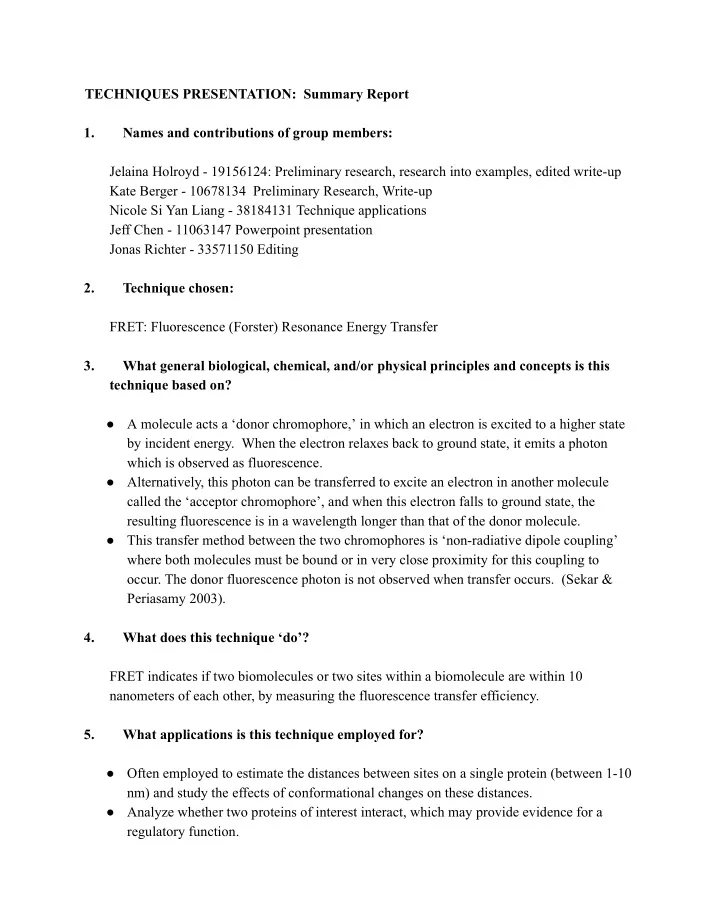

TECHNIQUES PRESENTATION: Summary Report 1. Names and contributions of group members: Jelaina Holroyd - 19156124: Preliminary research, research into examples, edited write-up Kate Berger - 10678134 Preliminary Research, Write-up Nicole Si Yan Liang - 38184131 Technique applications Jeff Chen - 11063147 Powerpoint presentation Jonas Richter - 33571150 Editing 2. Technique chosen: FRET: Fluorescence (Forster) Resonance Energy Transfer 3. What general biological, chemical, and/or physical principles and concepts is this technique based on? ● A molecule acts a ‘donor chromophore,’ in which an electron is excited to a higher state by incident energy. When the electron relaxes back to ground state, it emits a photon which is observed as fluorescence. ● Alternatively, this photon can be transferred to excite an electron in another molecule called the ‘acceptor chromophore’, and when this electron falls to ground state, the resulting fluorescence is in a wavelength longer than that of the donor molecule. ● This transfer method between the two chromophores is ‘non-radiative dipole coupling’ where both molecules must be bound or in very close proximity for this coupling to occur. The donor fluorescence photon is not observed when transfer occurs. (Sekar & Periasamy 2003). 4. What does this technique ‘do’? FRET indicates if two biomolecules or two sites within a biomolecule are within 10 nanometers of each other, by measuring the fluorescence transfer efficiency. 5. What applications is this technique employed for? ● Often employed to estimate the distances between sites on a single protein (between 1-10 nm) and study the effects of conformational changes on these distances. ● Analyze whether two proteins of interest interact, which may provide evidence for a regulatory function.
● Determine the distance between selected nucleotides in a sequence of DNA. ● Ideal for weak or transient interactions that cannot be detected by traditional techniques. (Sprenger et al. 2012) 6. What questions relating to gene regulation and/or development can be addressed using this technique? Provide two examples (peer-reviewed papers) that use this technique. i) DNA Template Directed Dye-Terminator Incorporation (TDI): ● FRET can be used as a diagnostic test to determine whether an individual carries a gene linked to certain developmental disorders. Patient genes are amplified with PCR using nucleotides with fluorescence markers attached. In one example, if a cancerous mutation was present, a nucleotide with a green chromophore was assembled beside a nucleotide with a red chromophore. Thus, the observation of red fluorescence was a positive test result (Chen et al. 1997). This method was also used to show if a fetus expressed the mutation for cystic fibrosis during development. ii) Visualization of Receptor Interactions with GFP-Based FRET: ● FRET can be used to determine how various environmental conditions cause proteins to interact and regulate gene expression. To study gene regulation of stress response, FRET was used to visualize the dimerization of neuron receptor proteins in the presence of the hormone corticosterone (Nishi et al. 2004). 7. What critical reagents are required to use this technique? i) For GFP protein chromophores: ● Two transposon donor plasmids: contain promoter sequences, cDNA for different GFP colours, and genes for the corresponding proteins ● Transposase ● Appropriate cell line for expression ii) For post-translationally modified proteins: ● Chromophore molecules (eg. Fluorescein) iii) For DNA: ● Appropriate PCR reagents as well as Fluorescein labeled nucleotides 8. What critical information is required to be able to employ this technique? ● To express a GFP fusion protein, the gene sequence must be known. To attach a chromophore post-translationally, the primary structure of the protein must be known.
● Chromophores of proper wavelengths must be chosen. For efficient energy transfer, there must be over a 30% overlap between the emission spectrum of the donor and the excitation spectrum of the acceptor. However, there must also be separation of the spectra, so that fluorescence of the donor and acceptor can be determined individually (Dinant et al. 2008) 9. At least two resources/information sources that you recommend for learning more about this technique (one or more may be developed by your group): ● JoVE Video Journal Article: http://www.jove.com/video/2149/imaging-protein-protein-interactions-in-vivo (Seegar & Barton 2010) ● Nature Methods Review Article: http://www.nature.com/nmeth/journal/v5/n6/full/nmeth.1208.html (Roy et al. 2008) 10. List of references consulted: Chen, X., Zehnbauer, B., Gnirke, A., Kwok, P.-Y. (1997). “Fluorescence Energy Transfer Detection as a Homologous DNA Diagnostic Method.” Proc Natl Acad Sci USA. 94(20): 10756–10761. Dinant, C., van Royen, M. E., Vermeulen, W., Houtsmuller, A. B. (2008). “Fluorescence resonance energy transfer of GFP and YFP by spectral imaging and quantitative acceptor photobleaching.” J. Microsc. 231(Pt1): 97-104. doi: 10.1111/j.1365-2818.2008.02020.x. Nishi, M., Tanaka, M., Matsuda, K., Sunaguchi, M., Kawata, M. (2004). “Visualization of Glucocorticoid Receptor and Mineralocorticoid Receptor Interactions in Living Cells with GFP-Based Fluorescence Resonance Energy Transfer.” The Journal of Neuroscience. 24(21): 4918-4927. doi: 10.1523/JNEUROSCI.5495-03.2004 Roy, R., Hohng, S., Ha, T. (2008). “A Practical Guide to Single Molecule FRET.” Nature Methods. 5, 507 - 516 doi:10.1038/nmeth.1208. Seegar, T., Barton, W. (2010). “Imaging Protein-protein Interactions in vivo .” J. Vis. Exp. (44), e2149, doi:10.3791/2149 (2010).
Sekar, R. B., Periasamy, A. (2003). “Fluorescence resonance energy transfer (FRET) microscopy imaging of live cell protein localizations.” J. Cell. Biol. 160(5): 629-633. DOI: 10.1083/jcb.200210140. Sprenger, J. U., Perera, R. K., Götz, K. R., Nikolaev, V. O. (2012). “FRET Microscopy for Real-time Monitoring of Signaling Events in Live Cells Using Unimolecular Biosensors.” J. Vis. Exp. 66, e4081 doi:10.3791/4081.
Recommend
More recommend